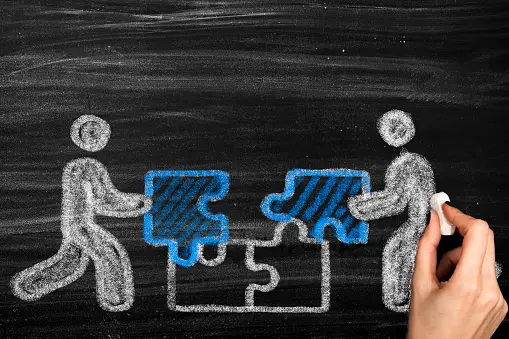If you’ve planned a company, you know there are many moving parts. It’s hard to find a central perspective. Luckily, the business model canvas helps!
The definition of a business model canvas
Business model canvases show all strategic factors. It’s a broad, comprehensive view of the company’s operations, customers, revenue streams, and more.
What is the purpose of a Business Model Canvas?
These canvases help companies visualize and analyze their strategy. New streams, markets, and expansions require model updates as the company grows.
Each department can contribute its unique domain knowledge to the business model canvas.
It defines the business and how each section works together. Understanding the value proposition, target customer, and channels they use must be done together, not separately.
Organizations can also plan, evaluate, and implement new models using the business model canvas. Thus, the canvas emphasizes key elements and ensures that nothing is overlooked. Strategy is incomplete if the canvas is incomplete.
Also, you can read: How to create a business model for a startup?
Business Model Canvas Elements
A business model canvas includes what?

Customer Segments
All businesses have customers. These are your customers or clients.
Focus on core customers first, then less important or potential future clients. The canvas should evaluate the following:
What do customers want now and soon?
What do your customers like, dislike, and find frustrating? Understanding this will help you approach them.
If your business involves multiple groups, this is crucial. Airbnb relies on satisfied property owners and guests.
You can also list future users. After success with the core audience(s), this will show future strategy directions.

Value Proposition
A company’s value proposition is its products and services and how they differentiate it from the competition. What makes this company better than others?
Osterwalder, the business model canvas creator, has also stated that organizations must offer something unique and immediately distinguishable from the competition.
Being cheaper, faster, more efficient, or more available than the competition is a value proposition. However, all values fall into two broad categories:
Quantitative:
Customers can easily compare benefits that can be counted. Price and speed are examples. Your cheaper or faster service may attract customers.
Qualitative:
This refers to intangible concepts like value or experience that evoke strong emotions in your audience. Local products, eco-friendliness, and customer-centricity are examples of this.
Asking what customers should remember expresses the core value. Which benefit should people highlight when recommending your business? It should be on the canvas because your company needs to promote this value.
Your value must also be maintained. If your value is being the only service in a region, what happens when a larger competitor moves in? The business model canvas should show these problems so that you can better plan for the future.
Channels
How will you interact with customers? Channels will depend on your customer and unique value.
If your audience is busy and mobile, a mobile-facing service is essential. If you’re targeting specific locations, you may need a physical presence. Consider all the touchpoints your customers may want and highlight the good ones.
The business model canvas may be updated as channels change.
Domino’s first options were calling or visiting the store. Internet and mobile applications quickly changed this, and now there are over 10 ways, including smart TVs, slack integration, and voice commands.
The business model canvas considered customer needs (efficiency and less effort) and their value proposition to define new channels.

Client Relations
This section covers customer relations. This includes how customers found you, how you kept them, and how the business will grow. Depending on your relationship goals, there are many factors to consider:
Personal care. These forms require customer service. Your company provides a direct, personalized approach to clients’ needs. This often involves assigning sales or business development staff to specific customers before and after the sale. For business clients, a bank may offer this. Your service and customers determine how dedicated this relationship is.
Automated self-service. You may not want a personal relationship. E-commerce customers want to browse and shop without talking to anyone. Personalization, like Netflix’s recommended viewing, can improve this without the customer knowing.
Communities. Establish a community if your target audience is a niche, segment, or region. Your business model brings like-minded people together to take action.
Revenue Sources
A business must profit. Revenue streams on the business model canvas show these channels.
The main revenue streams are:
Asset or goods sales: one of the oldest streams. Each sale generates revenue for the business.
Subscription: If you offer a recurring service or rent products, your customers pay monthly or annually as long as they use your business.
Leasing or lending: Like subscriptions, but for a set period. Customers choose the rental period before buying a car, for instance. Newer subscription-based models challenge this status quo.
Licensing: The business sells property licenses to other companies or individuals. The user can’t resell your intellectual property, unlike sale.
White labeling: Like licensing, it lets businesses rebrand their product or service. This is usually a subscription or one-time license purchase, making it a variant of the above.
Advertising: Does your model draw users but generate revenue from ads? Most famously, social media networks make money by charging advertisers to use their platforms.
These revenue streams will change with the market. To optimize each stream, businesses should revisit the canvas. This includes adding new streams or changing pricing plans, like Dominoes.
Key Assets
Every business needs resources to operate and deliver customer value. Like the others, this has many forms.
Human resources: if you offer personalized value or have a model that requires a lot of staff, consider employee cost and training.
Financial: how much does it cost to run a business before it makes money? More upfront money means more ROI pressure.
Physical: opening offices or buying property is another asset. High-street retailers and hotels need prominent positions. The shift to digital is relieving this resource strain for many businesses.
Intellectual property: everything needed to develop and maintain your IP (like an app). Since you own the IP, subscriptions, and licenses survive by preventing customers from using the service without you.
These factors help you determine what is available and needed to succeed. This is where you focus on what your previous channels need to succeed to create a sustainable business model.
Key Tasks
How do you create and promote your value proposition? This section covers key activities to make your model effective and connect with customers.
The initial investment may include finding a development company or advertising to raise awareness. This section should consider everything, including business impact, to determine the must-haves and nice-to-haves.

Key Partnerships
Few companies survive alone. Long-term survival requires identifying and preparing key partnerships. It would be helpful if you considered these main partnerships.
Distributors—how will you sell to customers? Distribute via online stores, sales agents, or other companies.
“Coopetition” means two competitors can compete in larger markets. This works when there are enough potential gains to make a joint venture financially viable. Smaller organizations can collaborate to offer a more comprehensive service to users or attend events outside their budgets.
Suppliers: Like distribution, you need suppliers for raw materials and software. If you need help to make something, find reliable suppliers.
Existing customers: Can you offer referral rewards or a commission-based system to raise awareness?
This will change too. As the business grows, you may need to switch partnerships. The business model canvas should include all of this.
Cost Structure
Finally, define all costs for business model canvas elements. To make a profit, you need to know how much you spent. Current and future costs are considered:
Fixed costs are the easiest to calculate because they have a fixed price. Example: rent.
Variable costs, however, have high peaks that must be considered. Businesses that need to maintain a certain temperature or humidity may spend more (or less) in warmer months.
As the business grows, economies of scale and scope reduce costs. Larger production can improve efficiency (scale), while new partnerships and internal process improvements can improve the organization (scope). For instance, you may use third-party providers for packaging but bring it in-house when it’s cost-effective.
Understanding these variables helps the business model canvas show current costs and where the company wants to be.
What Can a Business Model Canvas Do for You?
Quick visuals
With everything in one place, employees can quickly grasp the business model. It’s straightforward and provides a strategy-wide truth.
Fast Changes
Organizations can see how every part of the business interacts by connecting everything. People can point out issues or propose solutions here. The company can identify strategic improvements by comparing customers, revenue streams, and costs.
Shareable
Nobody wants a 2-hour business strategy presentation. The business model canvas definition better illustrates this plan. It can quickly bring newcomers up to speed, and simple changes can be shown on the updated canvas.
Conclusion
A business model canvas can bring your strategy together from initial costs to customer and revenue streams. Doing so involves all company departments and provides a broad but deep overview of the intended business model. The canvas is a great way to get an early overview and assess directions, whether proposing strategy updates or starting a new company.




